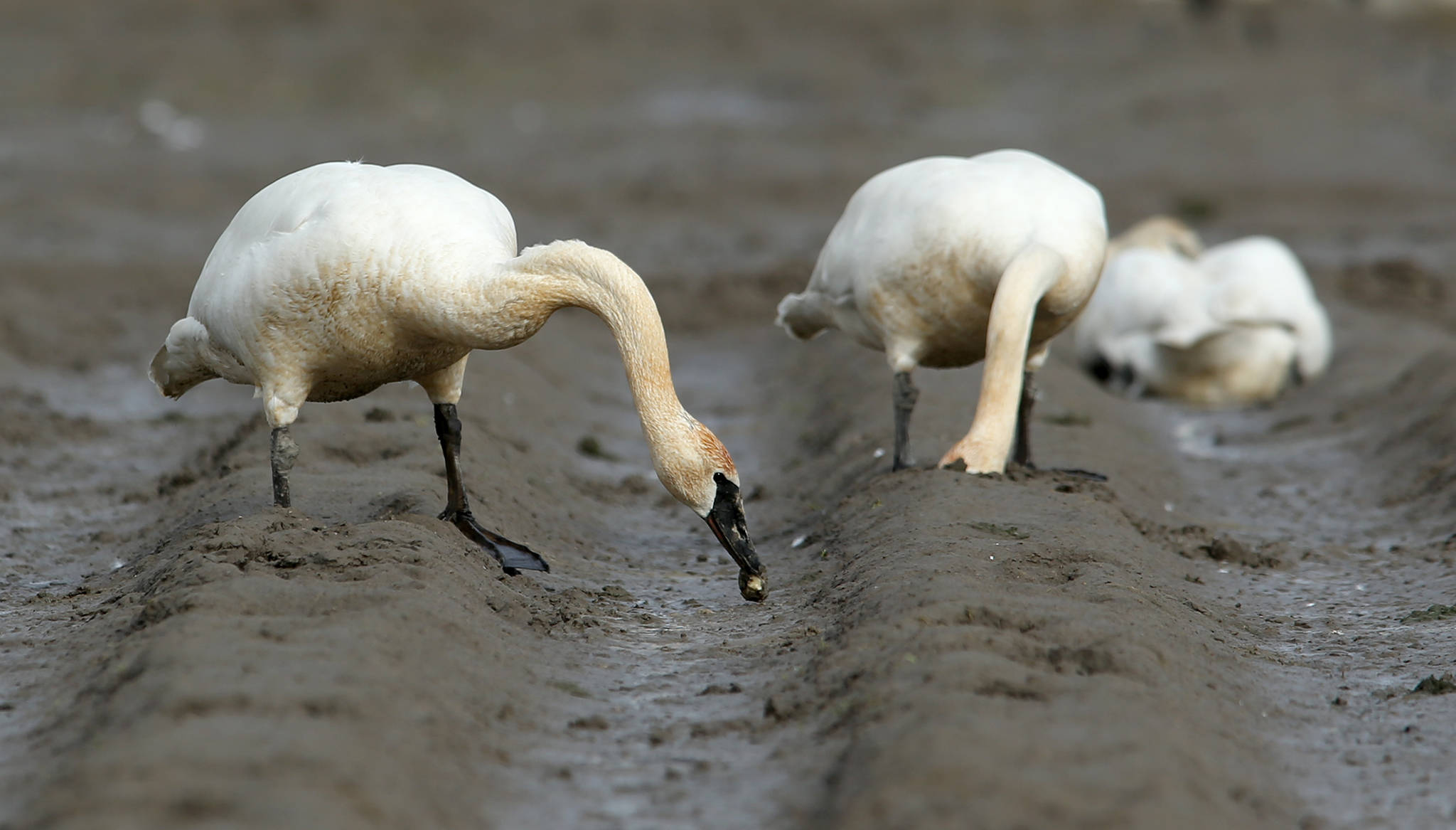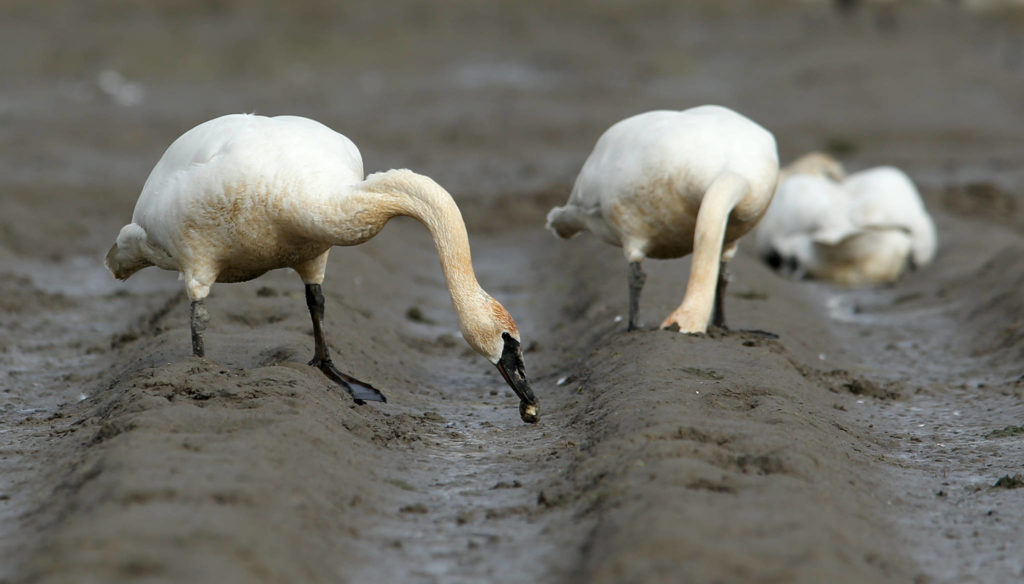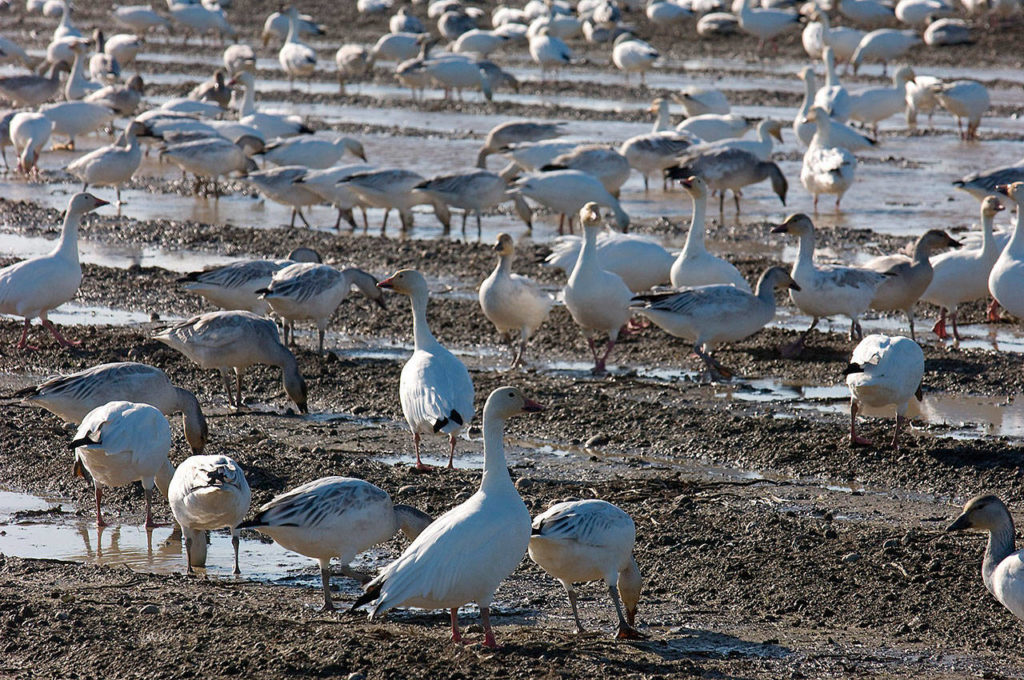By Bud McDole
Special to The Herald
For the tens of thousands of swans and snow geese that migrate here, it has been a winter like no other.
The birds can thank early rains in September for that.
Heavy rain fell before Snohomish, Skagit and Whatcom county potato farmers could finish harvesting. It turned the fields into a muddy mess that would not support the heavy machinery needed to dig up the spuds. Many farmers had to write off up to $5,000 per acre, and total losses exceeded $1 million in Skagit County alone, said Don McMoran of the Washington State University Extension in Mount Vernon.
It may have been a hit for farmers, but it was a big win for trumpeter and tundra swans and snow geese.
The birds center on Fir Island in Skagit County, but also spend a lot of time in farm fields in the Snohomish and Stillaguamish river valleys. They eat grasses, including rye grass planted as a cover crop for them, but have become increasingly interested in potatoes and corn.
As anybody who drives past the potato fields on Fir Island south of Mount Vernon can see, the birds have taken advantage of this potato buffet.
From dawn until dusk, the voracious migrants bury their heads into the soft loam-mounded rows until they find a potato, which they break into edible bites with their powerful beaks. The grassy fields that were swarming with geese and swans in prior years are virtually empty this year.
The Washington Department of Fish & Wildlife estimates 20,000 trumpeter swans, with a few tundra swans mixed in, are wintering in the Skagit River delta region. Local birders who monitor the area estimate that upwards of 90% of the swans this year are feeding exclusively in the potato fields. At up to 30 pounds, they’re the largest waterfowl in North America, so they surely welcome the new food source.
It wasn’t too many years ago that the trumpeter swan was on the Federal Endangered Species List. Hunted for meat and feathers for quill pens and ladies’ hats, trumpeter swans were nearly extinct by the late 1800s. More recently, they faced deadly peril from ingesting lead shotgun pellets left behind by hunters. Strict regulations limiting waterfowl hunting shotgun loads to steel or tungsten shot has given the trumpeter a new lease on life. Estimates place their numbers at nearly 100,000 going into the 2019-2020 winter season.
And the ubiquitous snow geese, whose numbers are estimated by state wildlife biologist Robert Waddell to be more than 200,000 in our area this winter, are gorging on spuds as well. They don’t normally feed alongside the trumpeter swan, but they’re making an exception for the potatoes.
Our Pacific Northwest snow geese spend the summer on Wrangel Island, off the northern coast of Siberia. There, about a half million of them breed, nest and raise their young on a slab of mostly tundra 90 miles long and 50 miles wide.
In early October, as winter begins to cloud the island with snow and ice, this massive flock of beautiful white birds with their black-tipped wings start their 4,000-mile trek to spend five months enjoying our temperate winter climate.
Snow geese populations are growing by leaps and bounds across North America. Pacific Northwest flocks have grown by about 350% over the past 10 years. The expansion has been far greater in the Midwest, leading to overpopulation and damage both to Middle America farmlands and the Arctic tundra where the geese spend their summers during the breeding season. There are simply not enough natural predators to significantly reduce the number of snow geese, although polar bears have begun feasting on nesting geese since the melting Arctic ice cap is offering fewer seals for them to eat.
In the U.S., regulators are allowing hunters to take unlimited numbers of snow geese. So far, it seems to be having little effect on reducing snow geese numbers.
Although massive flocks of snow geese are damaging habitat elsewhere, local potato farmers say they aren’t concerned about long-range damage to their fields.
In the meantime, it’s a great winter for viewing these magnificent — if muddy-headed — birds.
Bud McDole lives at the Warm Beach Senior Community. He has studied and observed snow geese and trumpeter swans since moving there 10 years ago. He gives lectures and sponsors bus tours to see the birds at the annual Port Susan Snow Goose & Birding Festival.
Birdwatching tips
Until hunting season closes on Feb. 18, snow geese change their feeding fields at random. I suggest that you wait until after Feb. 18 and give them a week or two to calm down after the hunting pressure is gone and then visit the many fields on Fir Island. The geese will be here until early April.
To see snow geese and swans in the potato fields, drive north on I-5 to Exit 221. From there, you can:
• Turn right and drive about 100 yards to Cedardale Road. Turn left. Drive about 1 mile on Cedardale Road to John Nelson Road, where there’s a large potato field where several hundred swans consistently feed.
• Turn left and drive through the roundabout to Fir Island Road. Continue about a quarter-mile and turn right onto Dike Road (just before the bridge crossing the South Fork of the Skagit River). You’ll find excellent, close-up viewing of trumpeter swans along the first mile or two of Dike Road.
• Turn left and drive through the roundabout to Fir Island Road. Cross the South Fork bridge and then immediately turn right onto Skagit City Road. You’ll find numerous fields to the left where trumpeter swans feed close to the road.
— Bud McDole
If you go
The annual Port Susan Snow Goose & Birding Festival, set for Feb. 22-23, focuses on migratory birds. See wintering trumpeter swans and snow geese in the Stanwood area, as well as on Fir Island near Conway. Sign up for birding classes, seminars and bus tours. More at www.snowgoosefest.org.
Talk to us
> Give us your news tips.
> Send us a letter to the editor.
> More Herald contact information.



























